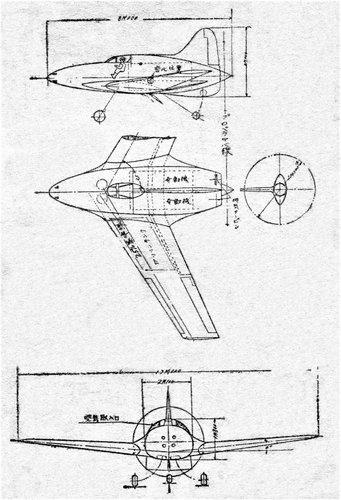Johnbr
ACCESS: Top Secret
- Joined
- 6 May 2007
- Messages
- 753
- Reaction score
- 312
DATA
Engine: two 1700hp liquid-cooled inverted V 12cylinder
Span: 13.2m
Length: 8m
Height: 4m
Main wing area: 23.8sqm
Wing load: 189kg/sqm
Max. speed: 720km/h
Range @ cruising speed: 1,500km
Fuel: 2200l
Crew: 1
Armament: 2 X 30mm, 2 X 12.7mm
"Seiku" (Sky Dominator) is a fast fighter with high climbing speed.
The engines are installed in the same fashion like on the Heinkel 177 and drive a 4-blade propeller via an extension shaft.
Each engine has a turbine exhaust coming out from both sides of the fuselage.
Air intakes are behind both sides of the cockpit with a radiator installed in the middle.
Designed by: Ikeda from Yokohama & Maruyama from Yokosuka
Featured in the November 1944 issue of the magazine "Koku Shonen" (Aviation Youth)
The "aviation expert" of the magazine commented that it is a fantastic design that only needs a little attention in the landing gear and the nose.
 Okay, this is one of the most interesting designs in the whole series because it is EXACTLY like the Lippisch P10-108, a 1942 German bomber project that never left the drawing board. From the overall shape and tail-less concept down to the two engines joined side-by-side, the 4-blade props and the extension shaft, the two designs are identical in every respect! Ofcourse it looks a lot like the Me 163 Komet but to me it is really amazing that two amateur Japanese designers thought in exactly the same way and took the aircraft in the same direction the Lippisch designers did.
Okay, this is one of the most interesting designs in the whole series because it is EXACTLY like the Lippisch P10-108, a 1942 German bomber project that never left the drawing board. From the overall shape and tail-less concept down to the two engines joined side-by-side, the 4-blade props and the extension shaft, the two designs are identical in every respect! Ofcourse it looks a lot like the Me 163 Komet but to me it is really amazing that two amateur Japanese designers thought in exactly the same way and took the aircraft in the same direction the Lippisch designers did.
Engine: two 1700hp liquid-cooled inverted V 12cylinder
Span: 13.2m
Length: 8m
Height: 4m
Main wing area: 23.8sqm
Wing load: 189kg/sqm
Max. speed: 720km/h
Range @ cruising speed: 1,500km
Fuel: 2200l
Crew: 1
Armament: 2 X 30mm, 2 X 12.7mm
"Seiku" (Sky Dominator) is a fast fighter with high climbing speed.
The engines are installed in the same fashion like on the Heinkel 177 and drive a 4-blade propeller via an extension shaft.
Each engine has a turbine exhaust coming out from both sides of the fuselage.
Air intakes are behind both sides of the cockpit with a radiator installed in the middle.
Designed by: Ikeda from Yokohama & Maruyama from Yokosuka
Featured in the November 1944 issue of the magazine "Koku Shonen" (Aviation Youth)
The "aviation expert" of the magazine commented that it is a fantastic design that only needs a little attention in the landing gear and the nose.
 Okay, this is one of the most interesting designs in the whole series because it is EXACTLY like the Lippisch P10-108, a 1942 German bomber project that never left the drawing board. From the overall shape and tail-less concept down to the two engines joined side-by-side, the 4-blade props and the extension shaft, the two designs are identical in every respect! Ofcourse it looks a lot like the Me 163 Komet but to me it is really amazing that two amateur Japanese designers thought in exactly the same way and took the aircraft in the same direction the Lippisch designers did.
Okay, this is one of the most interesting designs in the whole series because it is EXACTLY like the Lippisch P10-108, a 1942 German bomber project that never left the drawing board. From the overall shape and tail-less concept down to the two engines joined side-by-side, the 4-blade props and the extension shaft, the two designs are identical in every respect! Ofcourse it looks a lot like the Me 163 Komet but to me it is really amazing that two amateur Japanese designers thought in exactly the same way and took the aircraft in the same direction the Lippisch designers did.